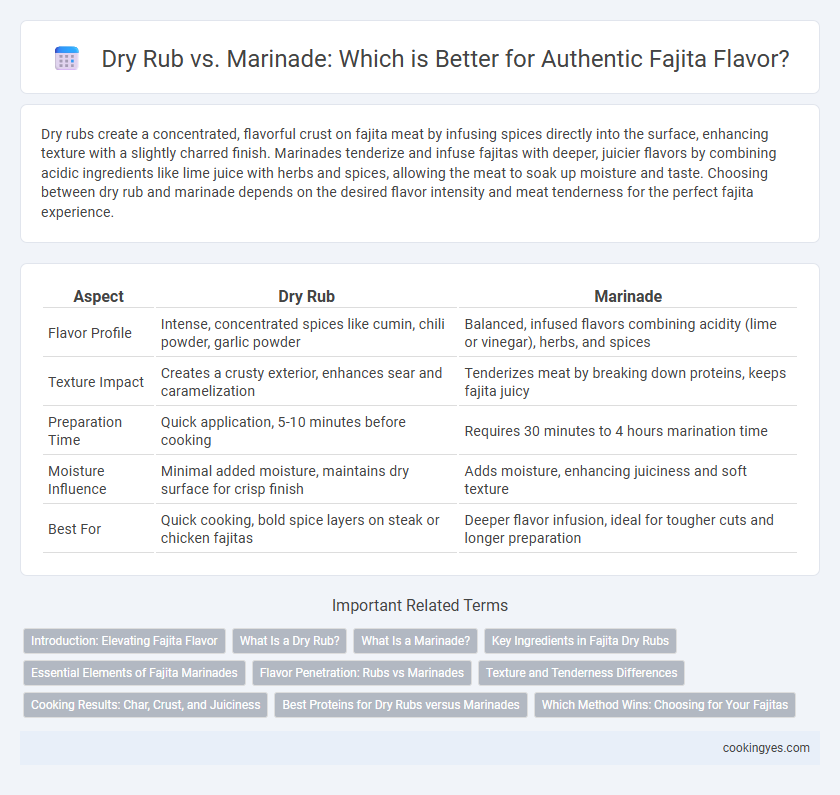Dry rubs create a concentrated, flavorful crust on fajita meat by infusing spices directly into the surface, enhancing texture with a slightly charred finish. Marinades tenderize and infuse fajitas with deeper, juicier flavors by combining acidic ingredients like lime juice with herbs and spices, allowing the meat to soak up moisture and taste. Choosing between dry rub and marinade depends on the desired flavor intensity and meat tenderness for the perfect fajita experience.
Table of Comparison
| Aspect | Dry Rub | Marinade |
|---|---|---|
| Flavor Profile | Intense, concentrated spices like cumin, chili powder, garlic powder | Balanced, infused flavors combining acidity (lime or vinegar), herbs, and spices |
| Texture Impact | Creates a crusty exterior, enhances sear and caramelization | Tenderizes meat by breaking down proteins, keeps fajita juicy |
| Preparation Time | Quick application, 5-10 minutes before cooking | Requires 30 minutes to 4 hours marination time |
| Moisture Influence | Minimal added moisture, maintains dry surface for crisp finish | Adds moisture, enhancing juiciness and soft texture |
| Best For | Quick cooking, bold spice layers on steak or chicken fajitas | Deeper flavor infusion, ideal for tougher cuts and longer preparation |
Introduction: Elevating Fajita Flavor
Dry rubs intensify fajita flavor by infusing bold spices directly into the meat's surface, creating a robust, textured crust that enhances grilling. Marinades penetrate deeper, combining acidity and seasoning to tenderize and impart complex, juicy flavors essential for authentic fajitas. Choosing between dry rub and marinade depends on desired flavor depth and meat tenderness, both elevating fajita taste in distinct, complementary ways.
What Is a Dry Rub?
A dry rub is a blend of ground spices and herbs applied directly to the surface of fajita meat, enhancing its flavor through a concentrated seasoning crust. Unlike marinades, dry rubs do not introduce moisture but create a flavorful bark during cooking, intensifying the taste and texture. Common dry rub ingredients for fajitas include cumin, chili powder, paprika, garlic powder, and salt, which penetrate the meat's exterior without the need for soaking.
What Is a Marinade?
A marinade for fajitas is a flavorful liquid mixture typically composed of acidic ingredients like lime juice or vinegar, combined with oil, herbs, and spices that tenderize and infuse the meat with deep flavor. Unlike dry rubs, marinades penetrate the meat, enhancing juiciness and creating a more complex taste profile essential for authentic fajita seasoning. Common marinade ingredients include garlic, cumin, chili powder, and cilantro, which complement the smoky, charred notes developed during grilling.
Key Ingredients in Fajita Dry Rubs
Fajita dry rubs typically combine key ingredients such as chili powder, cumin, smoked paprika, garlic powder, and onion powder to create a robust and smoky flavor profile. These spices adhere directly to the meat, intensifying its taste during grilling by forming a flavorful crust. Unlike marinades, dry rubs do not add moisture but enhance the fajita's texture and concentrated spice without dilution.
Essential Elements of Fajita Marinades
Fajita marinades typically combine key ingredients such as lime juice, garlic, cumin, chili powder, and olive oil to tenderize and infuse the meat with bold, zesty flavors. Unlike dry rubs, marinades penetrate the meat, enhancing juiciness and depth through acid and oil balance that breaks down proteins and locks in moisture. Essential elements include an acid for tenderizing, oil for flavor absorption, and spices for authentic Tex-Mex character.
Flavor Penetration: Rubs vs Marinades
Dry rubs create a concentrated layer of spices on the surface of fajita meat, delivering intense immediate flavor but limited penetration beyond the exterior. Marinades, composed of acidic and oily components, enhance flavor penetration by breaking down muscle fibers and infusing the seasoning deeper into the meat. For maximum flavor infusion throughout the fajita, marinades offer superior penetration compared to the surface-bound profile of dry rubs.
Texture and Tenderness Differences
Dry rubs for fajitas create a flavorful crust that enhances texture by adding a slightly crispy exterior, while marinades penetrate the meat to break down proteins, resulting in increased tenderness. The acid and enzymatic components in marinades soften muscle fibers, making fajitas juicier and more tender compared to the surface-only seasoning effect of dry rubs. Choosing between dry rub and marinade affects not only flavor intensity but also the texture contrast and mouthfeel of the final dish.
Cooking Results: Char, Crust, and Juiciness
Dry rubs create a robust crust with intense char by caramelizing the spices directly on the meat, enhancing the fajita's smoky flavor and providing a satisfying texture. Marinades penetrate the meat, boosting juiciness and tenderness while infusing deeper, more complex flavors, though they produce a softer crust with less char. Choosing between dry rub and marinade impacts the balance between a crispy exterior and moist interior, tailoring the fajita's overall taste experience.
Best Proteins for Dry Rubs versus Marinades
Dry rubs enhance the flavor of firmer proteins like skirt steak, flank steak, and chicken breast by creating a robust crust that locks in juices during grilling. Marinades work best with tender proteins such as shrimp, pork tenderloin, and chicken thighs, infusing moisture and complex flavors through acid and enzyme breakdown. Choosing the appropriate method boosts texture and flavor, making skirt steak ideal for dry rubs while shrimp favors marination for optimal fajita taste.
Which Method Wins: Choosing for Your Fajitas
Dry rubs deliver intense, concentrated flavor by coating fajita meat with a blend of spices that form a flavorful crust during grilling, enhancing texture and char. Marinades infuse moisture and depth by soaking the meat in acidic and aromatic ingredients, which tenderize and enrich the overall taste profile. For quick preparation and robust seasoning, dry rubs are ideal, while marinades suit those seeking juiciness and complex flavors; the best choice depends on desired texture and flavor intensity.
Dry rub vs Marinade for Fajita flavor Infographic

 cookingyes.com
cookingyes.com